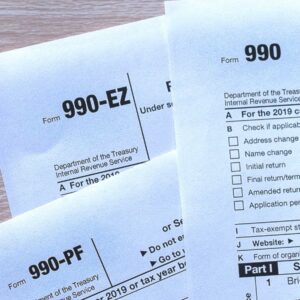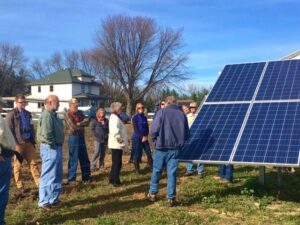RECs make a 93% improvement!
Minnesota’s rural electric cooperatives (REC) are starting to heed the call to improve member-owner engagement through enhanced transparency. This is a significantly different place than RECs were in 2018 when CURE began to measure and track co-op governance and transparency policies via the REC Scorecard.
 What’s new:
What’s new:
The 2023 iteration of the scorecard encouraged RECs to self-report their scorecard data. We found that self-reporting RECs scored higher in every category than RECs who opted to be surveyed.
In addition, CURE asked co-ops how they communicated with member-owners about the historic REC funding passed in 2022 as part of the Inflation Reduction Act, which we now know as the Empowering Rural America (New ERA) program.
CURE’s growing influence on co-op democracy
The new Scorecard categories and the original criteria measured over the last five years establish a clearly identifiable connection between CURE’s member-owner advocacy and the expansion of transparent governance in Minnesota’s rural electric cooperatives.
Healthy rural communities need democratic electric co-ops
 Electric co-ops are integral to the health and vitality of the rural and suburban communities and economies they serve. CURE champions co-op transparency and readily engage with co-ops because we know democratic co-ops are healthy co-ops— and rural communities’ place in a clean energy future depends on this. The idea of improving electric co-op transparency and re-engaging co-op members did not start with CURE. CURE’s original REC scorecard grew out of two reports, one from Rep Jim Cooper (C-TN) in 2008 and one from the National Rural Electric Cooperative Association’s (NRECA) Electrical Cooperative Governance Task Force report (ECGTF) in 2018. These reports highlighted the opaque governance issues in America’s electric co-ops. They identified areas where co-ops should be providing more information to member-owners. A recent survey of REC member-owners also found a growing desire for digital communications.
Electric co-ops are integral to the health and vitality of the rural and suburban communities and economies they serve. CURE champions co-op transparency and readily engage with co-ops because we know democratic co-ops are healthy co-ops— and rural communities’ place in a clean energy future depends on this. The idea of improving electric co-op transparency and re-engaging co-op members did not start with CURE. CURE’s original REC scorecard grew out of two reports, one from Rep Jim Cooper (C-TN) in 2008 and one from the National Rural Electric Cooperative Association’s (NRECA) Electrical Cooperative Governance Task Force report (ECGTF) in 2018. These reports highlighted the opaque governance issues in America’s electric co-ops. They identified areas where co-ops should be providing more information to member-owners. A recent survey of REC member-owners also found a growing desire for digital communications.
Democracy grows in daylight
The REC Scorecard measures a wide range of transparency and governance practices — like providing explanations for complicated billing practices or minutes from the last meeting of the board of directors. Minnesota electric co-op member-owners have more complete access to information about their co-op’s elections, operations, and other key transparency measures thanks to CURE’s REC work. In the previous five years, nearly every one of Minnesota’s 44 RECs has improved its score as measured by CURE’s REC Scorecard. In 2018, only six RECs scored higher than 50%; now, more than half scored 90% or higher.
Still missing: financial transparency
 While RECs have made great strides in making more information available to members, financial transparency still needs to be improved. RECs must file a Form 990 with the Internal Revenue Service to maintain their 501(c)12 tax-exempt status. Only about 1 in 4 RECs post their Form 990 on their websites. Posting a Form 990 is one easy way RECs can be transparent about manager and director salaries. Form 990 is a standard and publicly available document. But just because their Form 990s can be found in other places doesn’t mean that REC members should have to hunt for them. RECs should make it as easy as possible for their member-owners to access this information.
While RECs have made great strides in making more information available to members, financial transparency still needs to be improved. RECs must file a Form 990 with the Internal Revenue Service to maintain their 501(c)12 tax-exempt status. Only about 1 in 4 RECs post their Form 990 on their websites. Posting a Form 990 is one easy way RECs can be transparent about manager and director salaries. Form 990 is a standard and publicly available document. But just because their Form 990s can be found in other places doesn’t mean that REC members should have to hunt for them. RECs should make it as easy as possible for their member-owners to access this information.
New ERA could transform rural communities
 CURE found that 61% of RECs include some information about the Inflation Reduction Act on their websites. However, RECs fail to convey the historic nature of the IRA and the tremendous opportunity RECs have to transition to clean energy generation through the Inflation Reduction Act and the New ERA program. The member communications were comprised of language from NRECA fact sheets that offered very little explaining the information to member-owners and did not mention the over $10 billion in funding for new infrastructure. Many qualifying communications focused on tax incentives to make home energy upgrades. While home-based changes are a necessary part of our clean energy transition, they pale in comparison to the greenhouse gas emissions reductions that could be achieved by retiring coal and natural gas power plants and investing in renewable baseload infrastructure such as wind, solar, and battery storage. New ERA investments are poised to reinvigorate the economic landscape of rural communities.
CURE found that 61% of RECs include some information about the Inflation Reduction Act on their websites. However, RECs fail to convey the historic nature of the IRA and the tremendous opportunity RECs have to transition to clean energy generation through the Inflation Reduction Act and the New ERA program. The member communications were comprised of language from NRECA fact sheets that offered very little explaining the information to member-owners and did not mention the over $10 billion in funding for new infrastructure. Many qualifying communications focused on tax incentives to make home energy upgrades. While home-based changes are a necessary part of our clean energy transition, they pale in comparison to the greenhouse gas emissions reductions that could be achieved by retiring coal and natural gas power plants and investing in renewable baseload infrastructure such as wind, solar, and battery storage. New ERA investments are poised to reinvigorate the economic landscape of rural communities.